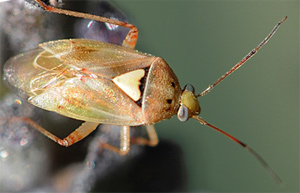Summary
Investigator: Sean Swezey, Center for Agroecology and Sustainable Food Systems, University of California, Santa Cruz
Project locations: Pacific Gold Farms, Watsonville, California
Previous OFRF-funded project work has documented improved, organically compliant, non-chemical suppression of lygus bugs with a combination of alfalfa trap cropping and tractor-mounted vacuums. This trap cropping system reduces lygus bug-induced damage in strawberry rows adjacent to vacuumed trap crops when compared with the more typical approach of vacuuming strawberry plants without a trap crop.
This proposal seeks to integrate an imported biological control agent into managed alfalfa trap crops for improved lygus bug control in organic strawberry systems. By incorporating the selective endoparasitoid Peristenus relictus, which is a nymphal parasitoid of the lygus bug, a more balanced systems-management approach to key pest control is being achieved. Despite the disturbance created by repeated vacuuming in trap crops and strawberry rows, percent parasitism from P. relictus in lygus nymphs has been shown to be comparable to parasitism rates in un-vacuumed (control) treatments. In October, parasitism in vacuumed alfalfa and strawberries reached 49% and 17%, respectively. While these data point towards a successful integration of biological and mechanical suppression, additional data are required to help substantiate this result.
The objectives of our second year of research in 2008 are:
-
To further determine what levels of parasitism P. relictus attains while being consistently exposed to the disturbance caused by tractor-mounted vacuums in both trap crops and strawberries.
-
To continue to test the effects of floral resources on parasitism levels of lygus nymphs from annual and perennial plantings. It is thought that P. relictus is unable to access nectar from either strawberry or alfalfa flowers, and providing additional flower types may be important to increasing fecundity rates.
-
To further identify any spatial parasitism links between the insectary border and alfalfa trap crops found in production areas.
These efforts will help establish a relatively unique systems-management approach to lygus bug control in organic strawberries that offers physical suppression (vacuuming), integrated parasitism, and resources for sustained biological control.

